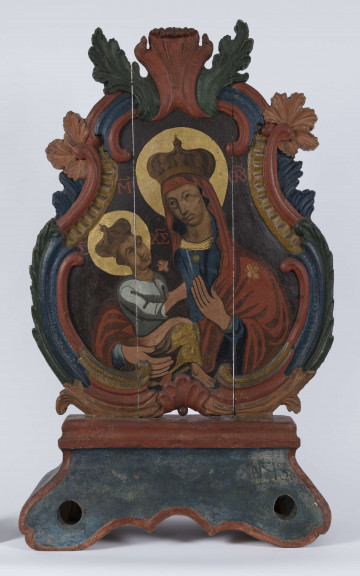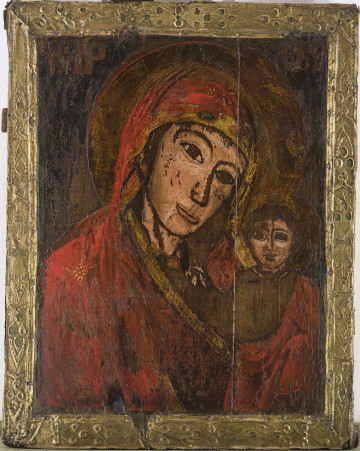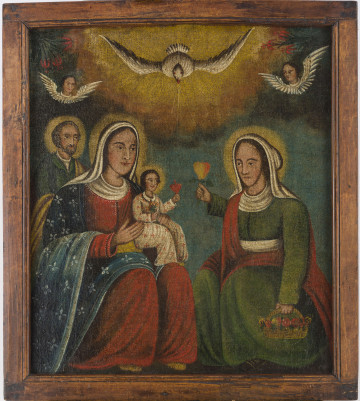
Our Lady of Chełm and Saint Nicholas
1801 — 1900
National Museum in Lublin
Part of the collection: Folk Art of the Lublin Region (17th–1st half of the 20th c.)
The Marian cult was approved by the Council of Ephesus in 431. Since then, there are numerous shrines throughout the world with miraculous images depicting Mary in various iconographic types, such as: Hodegetria, Eleusa or Ornata. In eastern Poland, the cult of the Mother of God was called the soul of Orthodoxy. Chełm icon, painted on canvas stretched on a cypress board, is one of the oldest representations of the Mother of God.
According to legend, the icon was brought as part of the dowry in 998 from Byzantium by Princess Anna, and then presented to Prince Vladimir I, who in 1001 built an Orthodox church for her on the High Hill of Chełm. Chronicle records point to Theodora, sister of Halych Prince Daniel I Romanowicz, who brought the icon from Kiev to Chełm in the mid-13th century. Sources also say that her brother ordered the icon to be decorated with precious stones and a gold cover. He also founded the Orthodox church, on the site of which stands today's Basilica of the Nativity of the Blessed Virgin Mary. After the Union of Brest was signed in 1596 and the Greek Catholic rite was introduced, the city and the church came under the protection of the Uniates. In the middle of the 17th century, during the Chmielnicki Uprising, the icon briefly returned to the Orthodox. In 1651, it was transported to Warsaw to accompany the military expeditions of King John Casimir and Michał Korybut Wiśniowiecki, and to contribute to victory in battles, including the Battle of Beresteczko. From that moment on, she began to be called the Madonna of War. It is reported that during one year about seven hundred graces and miracles were reported with the participation of the painting, which was crowned in 1765, according to the Catholic custom.
After the dissolution of the Union in 1875, the temple was turned into a cathedral, and the icon passed into the hands of Orthodox believers, only to be deported forty years later by clergymen evacuating with the retreating front of World War I deep into Russia. In 1919, a copy found in the attic of the church was placed in the main altar, which was replaced twenty years later. The replica of the painting, made by the Chełm painter Władysław Ukleja, was crowned three times. The found original is now in the Museum of Volhynian Icons in Łuck.
Author / creator
Dimensions
cały obiekt: height: 43,5 cm, width: 75,5 cm
Object type
icon painting
Technique
oleography
Material
canvas, printing ink
Creation time / dating
Creation / finding place
Owner
The National Museum in Lublin
Identification number
Location / status

1801 — 1900
National Museum in Lublin

1801 — 1900
National Museum in Lublin

1845 — 1855
National Museum in Lublin
DISCOVER this TOPIC
Museum of King Jan III's Palace at Wilanów
DISCOVER this PATH
Educational path